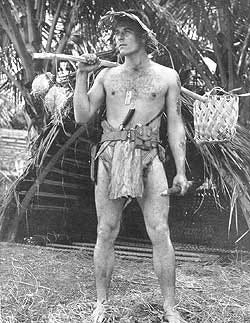School for Castaways
In WWII, one anthropologist got out of the museum and into the jungle to save lives
Meet Kenneth P. Emory.
Emory was born in Massachusetts and raised in Hawaii. He graduated from Dartmouth College and, though he had not formally studied anthropology, which was still in its early days, was hired as an assistant ethnologist at Honolulu’s Bishop Museum. After receiving the appointment, Emory said that he immediately had to find a dictionary to look up just what an “ethnologist” was (I did it too so you don’t have to: an ethnologist studies different societies and cultures).
At the time, the “problem of Polynesian origins” was a hot topic of scientific interest, and if you want to understand why, check out a map of the Pacific. Scientists, scholars, sailors, linguists, and armchair explorers were baffled by how the Polynesians had come to settle such far-flung islands as Hawaii, Easter Island, and New Zealand. Just who were these Polynesians, and how did they do it?
Emory got decades of experience in fieldwork, learning as much as he could about Polynesian society, culture, and history through archaeological and ethnological surveys in Hawaii, the Society Islands (which include Tahiti), the Tuamotu Archipelago, and more. During his work he encountered inhabitants of remote islands who still practiced a traditional way of life. In addition to recording chants, songs, and genealogies, Emory collected physical artifacts like fishhooks and tools for canoe-building as well as “considerable information on many ancient practices.”
This was all worthy and interesting in its own right. But it was to have a practical benefit that Emory couldn’t have foreseen.
When the United States entered World War II following the Japanese attack on Pearl Harbor, Emory, then 44 and living in Honolulu, was too old to enlist. As Christina Thompson relates in her wonderful book on the history of Polynesians and Polynesia and how we know what we think we know about this fascinating part of the world, Sea People:
“Emory was having dinner with a naval officer when the conversation turned to the question of what would happen to U.S. airmen if they were shot down over the Pacific. The officer argued that even if they managed to find ‘a desert island,’ they would certainly perish from starvation or thirst. Emory pointed out that Polynesians had been managing just fine for hundreds, if not thousands, of years and that there was food and water to be had on even the smallest islands if you knew where to look. Coconuts alone provided food, water, containers, and fuel for a fire; the problem was that most American servicemen had no idea how to husk one. Asked if he could teach them, Emory replied, Of course—all that was needed was a pointed stick. And so began his stint as survival instructor to the U.S. military in the Pacific theater.”
Men destined for the Pacific theater joined Emory for an intensive course in “jungle living.” They began with instruction at the Bishop Museum and then moved on to coastal areas “where conditions most nearly approximate those in the South Seas. They were introduced to the plant and animal life of reef and shore, and shown how these resources can be used towards solving problems of food, shelter, transportation, and maintenance.”
They learned the virtues of different foods they might encounter—breadfruit, taro, yams—and the many possibilities of the all-important coconut. They learned to husk and split them, to eat their meat and drink their fluid, to plait their leaves and make baskets, to light their husks and create a smoldering punk to cut down on match use, to rub their oil on sunburns, and to weave their leaves to build shelters. In addition to all this wonderful coconut knowledge, the men were “also taught what fruits to avoid, what fish are likely to be poisonous, how to use certain plants for cathartics, astringents, germicides, and antidotes for fish poisoning, and how to negotiate reefs without being knocked down by waves, cut by coral, or nipped by a shark.”
Yank Photos, by John A. Bushemi
As Emory explained, throughout the training, “Stress is constantly put on the fact that the techniques they are taught and the knowledge given come originally from natives, and that it is greatly to their advantage as soon as they are on an island in the South Seas to contact natives and add to the foundation for tropical island living given them while in Hawaii.”
Emory found that this hands-on training was not only interesting and enjoyable to the men, but helped alleviate some apprehension that many may have had about serving in a theater so distant from home and unlike anything they had known: “Dread of the unknown and boredom of waiting are replaced by lively anticipation and the pleasure of learning to be self-reliant in a world new to them.”
I love this story for many reasons. Emory was clearly a man who loved history and loved the people of Polynesia, and he devoted his life to learning as much as he could, preserving that knowledge, and passing it on. He seemed to realize that the best way to understand a place was to ask its people and listen with an open mind. When his country went to war, though he was too old to enlist in the armed forces, he used his specialized knowledge to contribute to the war effort in his own way, helping many individual servicemen and likely saving lives. Curiosity and passion can contribute to the greater good—as well as just make life a lot more fun and interesting.




Fascinating, I would never have known if not for this story!